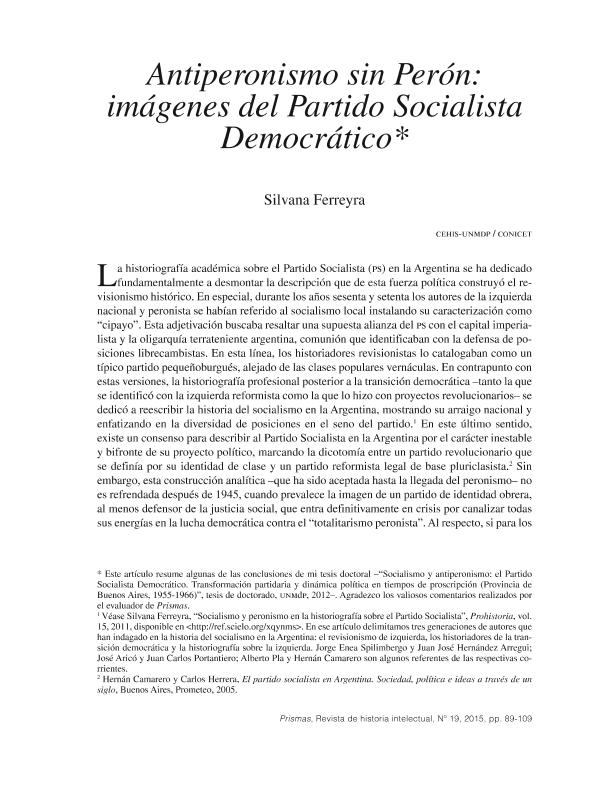Artículo
La imagen de Américo Ghioldi avalando los fusilamientos de civiles durante la "libertadora" ha cristalizado un conjunto de sentidos sobre esta fuerza política, acuñados por la historiografía revisionista y compartidos –paradójicamente– por la historiografía surgida al calor de la transición democrática. Nuestra intención no es desmentir imágenes que si se han consolidado fuertemente es en buena medida a raíz de su verosimilitud, sino historizar las relaciones entre socialismo y antiperonismo, diferenciando momentos y dimensiones en la trayectoria del Partido Socialista Democrático. En primer lugar, observamos cómo los usos del concepto de totalitarismo estuvieron cada vez menos asociados a la lucha contra el peronismo, cuya proscripción criticaron, y se asociaron cada vez más a la denuncia de comunistas y otros antiperonistas. En el marco de la guerra fría mostramos la convivencia entre el rechazo a las intervenciones norteamericanas en territorio latinoamericano y un apoyo parcial al bloque occidental. En segundo término, observamos cómo la lucha contra el totalitarismo no ocluyó el impulso a reformas económico-sociales que favorecieran a los grupos subalternos en general y a la clase obrera en particular. Vínculos con sindicatos, propuestas de racionalización administrativa y la cuestión peronista interfirieron de distintos modos con los proyectos que priorizaban el intervencionismo estatal. Americo Ghioldi's image as a man who supported the execution of civilians during the "Libertadora" has fixed meanings about this political force, which were built up by revisionist historiography and shared –paradoxically– with the historiography which sprang from the heat of the democratic transition. We do not intend to disprove such an image, as to a great extent it is its verisimilitude that led to its deep rootedness. Rather, we seek to historicize the relationships between Socialism and anti-Peronism by differentiating moments in and features of the Socialist Democratic Party. First, we observed how the concepts of totalitarianism became increasingly disconnected from the fight against Peronism, having disapproved of its proscription, and grew ever more associated with Communists and other anti-Peronists. We show two parallel discourses within the framework of the Cold War: resistance to American intervention in Latin American countries and a partial support to the Western bloc. In addition, we note that the fight against totalitarism did not weaken support for socio-economic reform, which would benefit subaltern groups in general and the working class in particular. Ties with unions, administrative rationalization plans and the Peronist issue hindered pro-interventionist proposals by various means.
Antiperonismo sin Perón: imágenes del Partido Socialista Democrático
Título:
Anti-Peronism without Perón: images of the Socialist Democratic Party
Fecha de publicación:
09/2015
Editorial:
Universidad Nacional de Quilmes
Revista:
Prismas
ISSN:
1852-0499
Idioma:
Español
Tipo de recurso:
Artículo publicado
Clasificación temática:
Resumen
Palabras clave:
Partido Socialista Democrático
,
Antiperonismo
,
Totalitarismo
,
Proscripción
Archivos asociados
Licencia
Identificadores
Colecciones
Articulos(CCT - MAR DEL PLATA)
Articulos de CTRO.CIENTIFICO TECNOL.CONICET - MAR DEL PLATA
Articulos de CTRO.CIENTIFICO TECNOL.CONICET - MAR DEL PLATA
Citación
Ferreyra, Silvana Gabriela; Antiperonismo sin Perón: imágenes del Partido Socialista Democrático; Universidad Nacional de Quilmes; Prismas; 19; 9-2015; 89-109
Compartir




